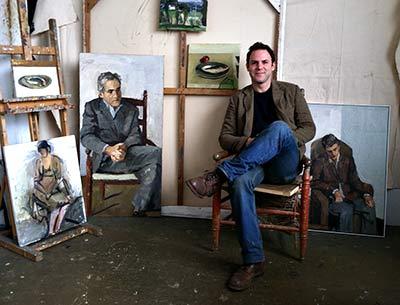Adrian Nivola: A Way of Seeing

We have always envied birds their ability to fly, and in the West, once Leonardo da Vinci had made drawings of his ornithopter in about 1505, it seemed only a matter of time before early primitive models would evolve into power-driven vehicles.
It was likely that patrons of Adrian Nivola’s first solo show of sculptures, which resembled flying machines imagined before such things could actually fly, had this in mind when they scooped all 24 of them up, selling out the August show at the Drawing Room in East Hampton in a matter of weeks.
"Flyer for a Retired Samurai" from 2014
Made with wire, aluminum, string, acrylic, linen, brass, silk, wood, and even watch parts, his sculptures are elegant three-dimensional drawings evoking the draftsmanship of Saul Steinberg, the mobiles of Alexander Calder, the paintings of Joan Miro, and the exquisite wearable sculptures made by Ruth Nivola, his paternal grandmother, who wove metallic yarns, silk, and gold thread into Etruscan-looking jewelry. The sculptures have a touching quality but also their share of whimsy.
"Black-Sailed Flyer for Theseus" from 2014
At his Brooklyn studio, Mr. Nivola, a Cambridge, Mass., native who spent summers with his father’s parents in Springs, acknowledged the debt these sculptures owe to architecture. For three years, he built models for the design firm of Chermayeff & Geismar.
“The scale thing is really important,” he said. “You cannot believe in the world of that structure and project yourself into it unless the parts are unified within the scale in a way that is consistent.”
Primarily a painter — he earned an M.F.A. at the New York Studio School of Drawing, Painting, and Sculpture after graduating from Yale College — Mr. Nivola had made a few sculptures of that type, but it was after someone sent him a photo of one of the pre-Wright Brothers pioneers a couple of years ago that he started to immerse himself. In the photo, “The inventor was the pilot and he had a sort of devil-may-care look combined with a terrified look,” he said. “These machines seemed to me to have an expressive power to them with expressions of the hope of flight, but they also have a desperate quality about them.”
He doesn’t make drawings in advance. “I don’t pre-plan anything . . . inventing as I go, trying to capture the spirit and the humor that’s partly related to their pathos.” It is the look of the machines that he captures, but even more inspiring is the courage of “the guys who were risking everything.” Mad scientists possessed with the idea of potential glory, some added bat-like wings in their efforts to stay aloft.
Mr. Nivola decided to be a painter after living in Carrara, Italy, for a year, as an apprentice to Caio Fonseca. He finds a similar feeling of being drawn in to the universe of sculpture in the work of such master painters as Bonnard, Manet, Matisse, Goya, Soutine, Turner, Vuillard, Cezanne, and Morandi, and aims to replicate it in his paintings as well.
“A painting is a balance of asymmetric forces,” he said. “The goal should be more than that, but it’s a necessary criterion for the painting to work. You have to have tenderness to draw out the expressive qualities of the subject — maybe it’s a form of empathy — that holds even if it’s a violent subject.”
Mr. Nivola has painted portraits that are subdued and quite affecting, especially the ones of family members. He enjoys the challenge of capturing the “different aspects of their character, trying to express several different poses in one body, or in the face to convey different states of mind in one head. . . . Their personality may contradict what their physiognomy shows.”
Fish are also a favorite subject for “their expressions and the attitudes they seemed to express: Some look angry and some have a beatific smile on their faces. It seemed to me I could make portraits of them the way I do of people” (and they pose for so much longer than humans).
He is inspired by the connection between color and light, even as he finds the task of achieving light with paint “endlessly complex, maddening, and impossible.” And he enjoys pondering the concept of “volume, which is what transforms a painting into something real . . . instead of looking at a design on a surface: The front of the painting is the back of your head and the back of the painting is the front of your head.”
To Mr. Nivola, painting is “a way of seeing,” the effect of the artist’s ability to “group forms, lines, and colors and separate them,” to organize and prioritize everything that is in front of him. He said that orchestration might be a better way to think of it, the producing of a sort of “visual music out of the subject . . . how to translate the subject into the medium of paint in such a way that it has the power, rhythm, and elegance of music — the tension-filled rests between the notes.”
He uses oil paint mainly because he likes “its viscosity and the luminosity that it’s capable of.” It’s a medium that can be handled in a lot of different ways and that has many possibilities, but at the same time, “it’s less of a flexible medium than you would think.”
Having the genes for all these endeavors, including playing jazz piano, Mr. Nivola does nonetheless have a preference: “Painting is my obsession, though I love to sculpt, too.”
